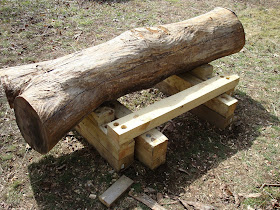
However, I avoided removing too much wood right near the end of the stem on the left side of the log, being somewhat concerned about the large split emanating from the pith. That split has been there since the log was cut, but I don't want to disturb it too much with axe impacts, out of fear of making the split wider, or even breaking a large portion of the stem off. So instead, I'll remove the rest of this wood using a small hatchet, or even a chisel. I may eventually put a stainless steel screw through the stem to hold it together. Or, perhaps, if I really wanted to get fancy, a butterfly key made from a section of black walnut I've been holding onto for just such an occasion, inserted into the end of the stem and made flush. Any suggestions or other ideas?

The mid-section of the log was also very problematic, as it consisted of a large bulge and the vestigial knot of a limb that had been removed from the tree a long time ago. The wood in this section was very deep, as you can see from the photo. So I decided to make this part of the log a candidate for splitting, according to my ever evolving plan. I cut two deep, narrow notches on each side of the knot (the highest clump of wood in the photo is the one holding the knot):

And then I went to get ... my splitting maul!

Ah, yes, my splitting maul easily strikes fear into the heart(wood)s of logs that otherwise eat chainsaws for breakfast. It made fast work of the first clump just behind the one containing the knot, in merely three strikes:

But the knot seemed not the least bit shaken, and clearly was mocking me as I cleared away shattered wood from the first clump:

Well, my splitting maul decimated nearly all of the clump containing the knot, as well as the next clump right below it. But admittedly, the maul bounced off the knot one or two times. That knot was determined not to be disturbed:

At this point, I was tired and decided to call it quits for the evening. I cleared away some of the wood on either side of the knot using my felling axe, but the core of the knot is still there. An effort to return to some other day:

Here's a view of the surface of the log just above the knot. I still need to shave some wood down to the layout line on this side, and there also is a slight bulge in the very center of this area that I need to take down a bit, as well:

The other side was generally right down to the line. You can see the black crayon line on the side of the log, just below the cut, in the foreground of the photo. Also note the interesting demarcation between the lighter layer of sapwood, and the darker heart wood in the center of the log:

Counting crows....My usual spectators also came by to watch at one point. Can you spot all the crows in this tree? There also was one on the ground at the time, but I couldn't get all of them into the photo:

































